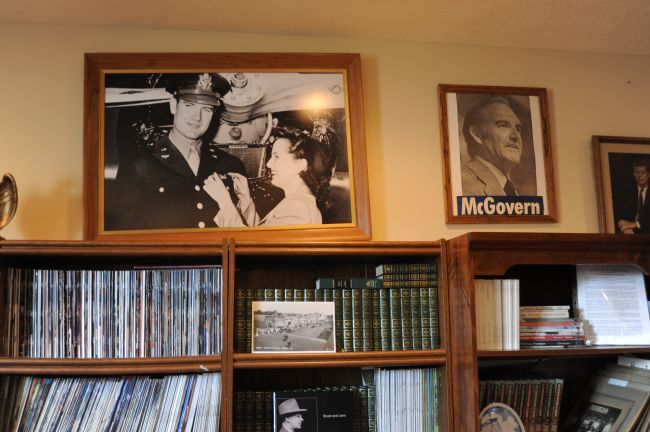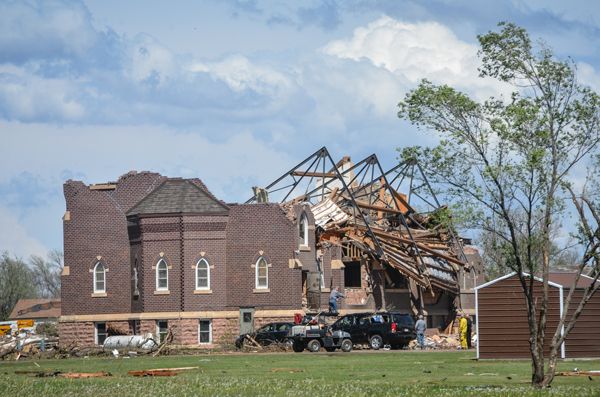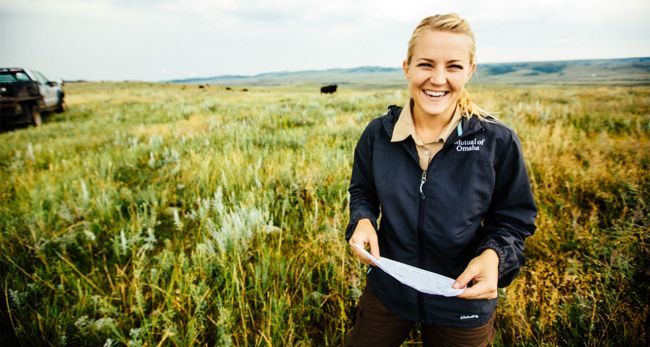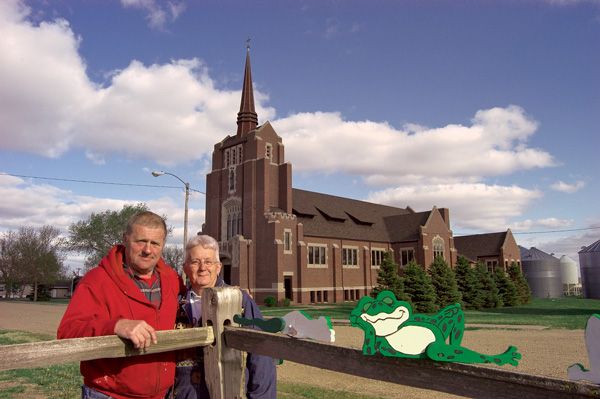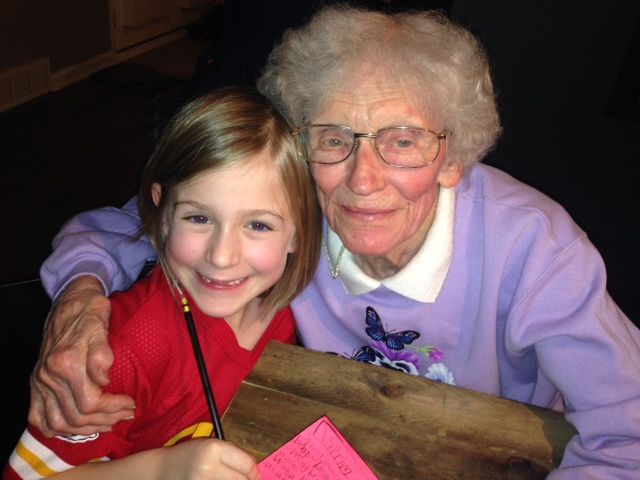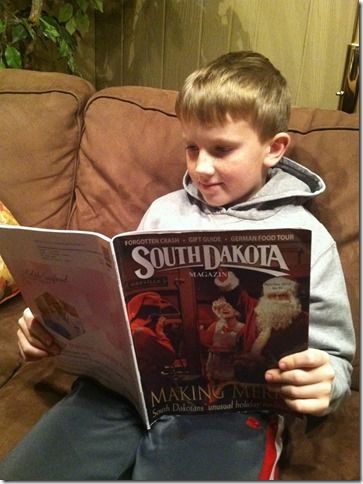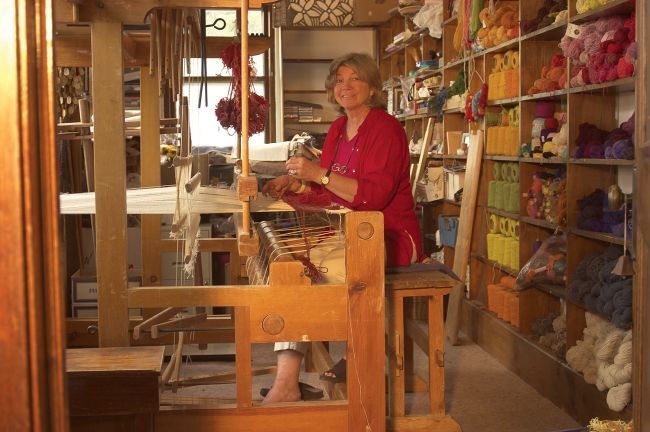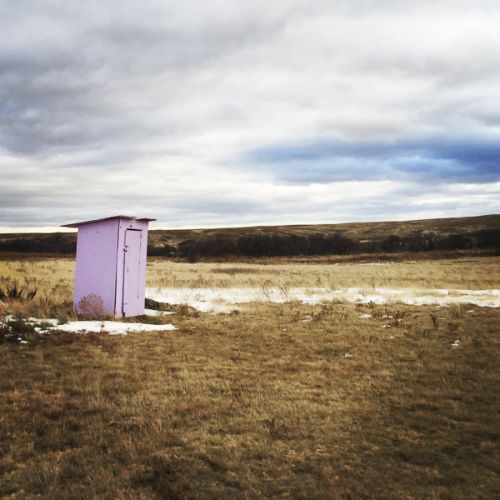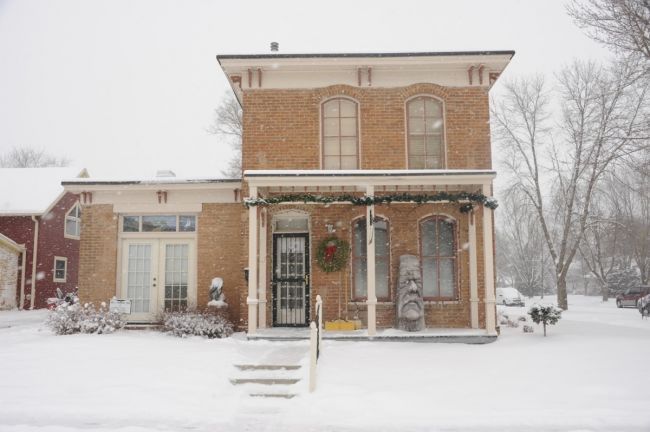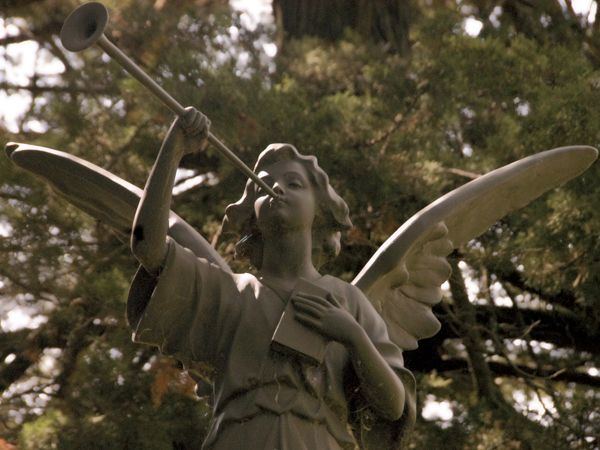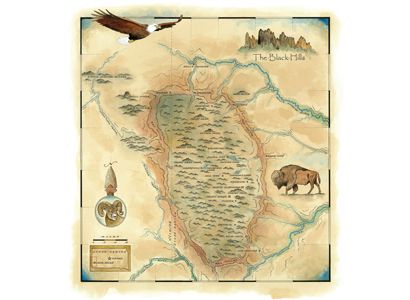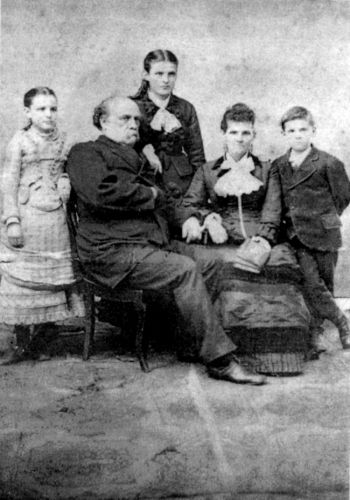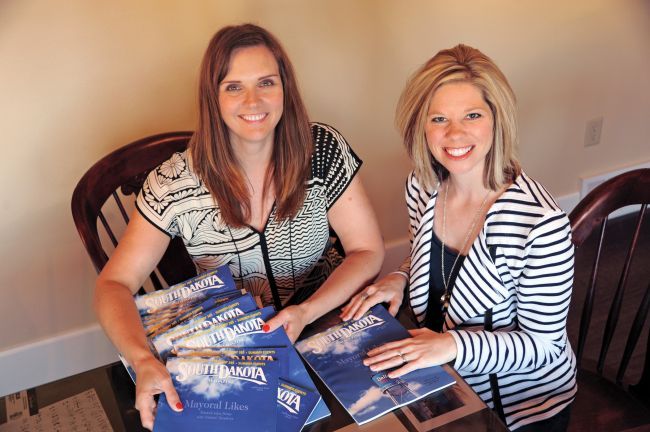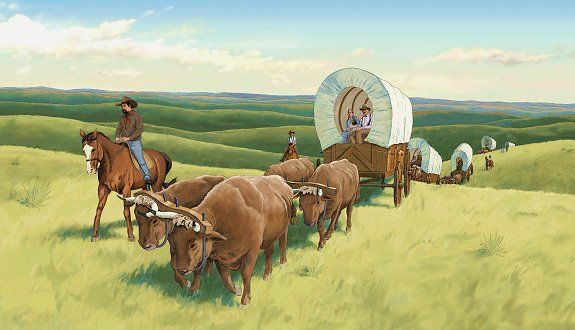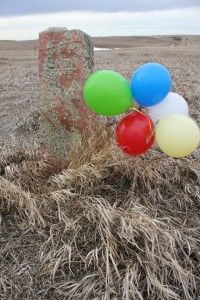
Editor's Notebook
Join our Editor-at-large and founder, Bernie Hunhoff, as he offers stories, quips & travel tips gathered as he roams South Dakota. Other magazine staffers may contribute here or there as well. Enjoy the South Dakota miscellanea.
Museum Politics in Viborg
May 14, 2015
“History is recorded by the victors,” said Winston Churchill.
“History is made by those who show up,” said Benjamin Disraeli, a 19th century Israeli leader. Combine his quote with Churchill’s and you have the answer to why the wonderful and not-so-little Daneville Heritage Museum in Viborg has such a nice collection of Democratic memorabilia.
We spent a morning this week in Viborg, working on a story that will be published in our July/August issue. This is an 800-population boom town in Turner County, one of the more Republican conclaves to be found in East River, South Dakota (not that Republican conclaves are rare by any means in the state). The well-kept little downtown has a hardware store, three restaurants, bank, hospital, grocery store, vintage auto restoration shop, historic movie theater and all the other amenities you might expect. Towns 10 times Viborg's size don’t have all that downtown.
And it has a wonderful museum that actually has a decent revenue stream. “We joke sometimes that the museum will be here long after the town,” says Rich Skola, who directs the facility. That’s because of the generosity of many local individuals and families, but especially because of Alphie “Toots" Peterson, an avid historian who donated much time and money.
Her husband, Merle, ran as a Democratic candidate for state legislature in the 1960s when Ralph Herseth and George McGovern were leading a resurgence of the party. She died two years ago, at age 94, leaving the museum some of her assets. She’s perhaps one reason why the Daneville museum has a 1960 poster of the Democratic ticket, with photos of Merle and McGovern and all the other candidates — along with a big poster of McGovern, plus an exhibit of Hubert H. Humphrey and other Democratic memorabilia.
Somewhere in the museum, there’s an Eisenhower collector’s plate, says Skola. A few visitors have kidded about the space given to Democrats in a Republican county. But nobody really seems to be bothered by the exhibits.
And it’s not that Turner County voters won’t elect Democrats. Roberta Rasmussen, a local farmer and activist, represented the district in the 1990s. Roberta has also been active with the local museum, and Skola says she may be more responsible for the Democratic paraphernalia than Toots. More recently, grocer Tom Jones was the state senator from Viborg.
So just show up, as Disraeli said 200 years ago. And save your posters and bumper stickers.
Note — In the spirit of complete transparency, we should note that the writer is a Democratic state senator from nearby Yankton County. That might help to explain his undue fascination with the above subject matter.
Damn Tornado
May 11, 2015
Damn the tornado. What else can you say about a soul-less storm that attacked the pastoral little town of Delmont on Mother’s Day morning?
Nine people were hurt. How badly we don’t know. But all of the 250 citizens of this town and all who care about it are also hurting. Not bleeding. Not bruised, perhaps. But hurting.
Here in South Dakota we like to be friends with Nature. She sustains us. Gives us sun and rain to grow and live. And yet every now and again, Nature erupts and we find that she’s neither friend or foe — but rather a force.
Most of us who live in southeast South Dakota know Delmont as a quiet little place between Mitchell and Yankton. Maybe you’ve heard of the Delmont pickle party? Or maybe you’re one of those who, while driving Highway 18 through Douglas County, turns north a mile or two to grab some of the amazing brats at the Blue Bird Locker. You check to see that the turret on the Onion House is still there. You see if anyone has done anything with the big brick grocery store with the murals. You admire the steeple on the Lutheran Church. You notice that everything is mowed and nicely tended downtown. And then you’re gone until next time.
Hearing of the destruction is hard enough for those of us who are casual fans of the town.
But for the 250 people who live there every day — and for the several thousand people who care deeply about them (yes, a town of 250 is always bigger than 250) — it must be unimaginable. Something only those who have suffered and survived such storms can understand.
Our May/June issue of South Dakota Magazine has stories from the survivors of last summer’s June 18 tornado in Wessington Springs. The Springs citizens were honest and frank about the experience. No sugar-coating or grandiose toughness. “I’m still going through it, it’s still hard,” said Donna Krueger, who lost her husband to cancer three months after the storm.
“It’s pretty hard to come back from,” said Ward Barber. “But what choice do we have? As long as we’re alive we’ll make some kind of memories.”
In Delmont, the Onion House is badly damaged. The Lutheran Church is cut in half. The town is evacuated.
Nature didn’t win and fortunately no one lost a life. The town is more than 125 years old. Life will go on for the town and its people, because it’s the nature of things. It’s going to be hard. Let’s look for ways to help.
— Bernie Hunhoff
Welcome, Mr. President
May 5, 2015
By Bernie Hunhoff
Mr. President, welcome to South Dakota. You’ll be landing Air Force One on Friday in the center of our great USA. The official geographic center is near Belle Fourche, a six-hour car drive straight west of where you’ll speak in Watertown.
In between are farms and ranches, towns and small cities — all populated by mostly hard-working and decent people who don’t expect much of the Washington whence you come.
Oh, we’ll take what we can get when offered. We’ve seen enough hard times — droughts, floods, hail storms and tornadoes — to know that you don’t bite anybody’s hand. But we don’t expect much. Most of us were raised with the belief that the next government check — like the next rain — might be the last for awhile, and we’re ok with that.
We figure we'd have the same number of farmers and ranchers if Washington had never sent a nickel through an ag program. We farm because we farm. For the sake of pure patriotism, we'd host Ellsworth Air Force Base for the nation even if it didn’t add a dime to the economy. Our Native American citizens would still call places like Pine Ridge and Standing Rock their home even if you tore up the treaties and never spent another dollar on the rez. And we would have probably allowed you (I say “you” because as president, you represent the government to us) to flood our middle section of the state by the four Missouri River dams even if we didn’t get some fine walleye fishing in exchange.
As a state senator, I can promise you that we’d find a way to balance our state budget if we lost the 40% that comes from Washington. It wouldn’t be easy, but we’d survive the same way we dig out of blizzards. One shovel after another. Our senior citizens appreciate Medicare and Social Security, but the cost of living is lower here so we’d probably even get by without those wonderful perks.
Washington is a million miles away from our daily lives.
I wish you had a a day or two to spend in South Dakota. You could take federal Highway 212 from Watertown and drive to Belle Fourche, past the most cussedly independent folks on our planet. Most of them don’t belong to your political party, but you could stop in any small town or pull into any farm driveway and you’d be met with the biggest smiles you’ve ever enjoyed. As a Democrat, you’d love the giant concrete donkey at Tinkertown, just west of Watertown, and the immense fiberglass pheasant at Redfield.
As you cross the great Missouri, America’s grandest river, you’ll enter the Cheyenne River Indian Reservation, one of the places where our government sent the Lakota. It hasn’t worked well from most viewpoints. Capitalism hasn’t taken root. Health care is a disaster. Alcoholism is a problem. But it is Home to the Lakota, with a capital H. The reservation people face many challenges, but it wouldn't take you long to find very spiritual and determined people who are working to make things better for the next generation.
The Cheyenne also marks the gateway to true cowboy country. On down Highway 212, you’ll want to stop for a hot beef sandwich and some conversation at the Faith Livestock Auction Barn. The salty ranchers of West River are everything Ronald Reagan dreamed of being.
South Dakotans neither love or hate the government you run. Likewise, most neither love or hate you. Oh, we have a few political nut cakes. But fewer than most places. Most South Dakotans are too busy with daily life to think a lot about Washington and all your problems.
But don’t get me wrong. I welcome you to South Dakota. We all welcome you. We’re always happy when folks come here and spend some money, just as we like a good rain.
South Dakota's Wildlife Ambassador
April 30, 2015
A young lady from South Dakota is the modern-day “Marlin Perkins” for Mutual of Omaha’s Wild Kingdom. Earlier this week I had a chance to get acquainted with her when she spoke at a meeting of South Dakota’s retired teachers in Pierre.
Stephanie Arne breaks all the molds. She was a high-achiever at Riggs High School in Pierre, and enjoyed her years as a biology student at South Dakota State University.
But she’s not the 9-5 type, so as soon as she got her degree in Brookings she took to the road — working for any wildlife organization that had an opening. It hardly seemed like a great career path. She took low wage jobs with the country’s finest zoos in Omaha, San Diego and Honolulu. Good experiences if you love critters, and she does. Not a good way to save for your first mortgage.
Even zoos couldn't hold her back. She eventually traveled the world for a decade, finding ways to work with animals in Thailand, Japan and Africa. She showed up in Australia without a clue as to how she was going to make ends meet, and soon she was giving wildlife tours on day charters.
She became known as a wildlife ambassador — a person passionate about birds and animals and the challenges they face on an fast-changing planet. “You should have a show,” friends kept saying.
And then she heard about a job opening with Mutual of Omaha’s Wild Kingdom, one of the most respected wildlife shows in the history of broadcasting. She and about 500 others applied. Upon meeting her, it’s no surprise that she won the position once held by renowned naturalists Marlin Perkins and Jim Fowler.
She acknowledged that while she always had the support of her parents and teachers, they probably didn’t figure she was on a great professional trajectory while earning barely sustainable wages, sometimes for scooping pelican poop. We expect our youth to be more responsible: stay safe, earn your way and fit the mold of today’s demanding workplace. Be a square peg in a square hole.
Fortunately, Stephanie followed her heart. She did what she loved, what she thought was important. By those important standards, she was a success even before she was chosen to host Wild Kingdom.
Steph strongly credits her South Dakota upbringing and education, and is proud to always call this home. Several of her teachers were in the audience as she spoke. Buttons were busting off their jackets as she spoke about the importance of a great teacher.
Now she’s teaching the world about the nature. She’s known as the wildlife ambassador, but she’s also a fine ambassador for Pierre and Brookings and our entire South Dakota. And for young people brave enough to resist the normal patterns of society.
Turton: Food, Frogs and Philosophy
March 18, 2015
Funny how so many memories of life in a small town revolve around food. That’s the thought that came to me as I thumbed through a little book called “Memories of Turton” that was sent to me awhile back by Kay Britten.
Turton is south of Aberdeen, a town of a few dozen with a magnificent old Catholic church. In June, the feast day of St. John the Baptist is celebrated with real gusto at St. Joe’s. The public school’s mascot was The Frogs, a reference to the French culture of the first settlers. Students now go to Doland and neighboring towns, but good-humored folks still carry on the frog theme.
The school and church are also fondly remembered in the little book, but they take second fiddle to the culinary delights of rural South Dakota.
Jean Barrie Sundvold related that she likes to tell about “when Dad was chopping the heads off the chickens in the backyard, and they would flop all over the yard. We canned them one year and had to take the meat off the drumsticks because they were too big to fit in a quart jar.”
On that same topic, Jeff Barrie reported that there is truth behind the old saying, “Running around with your head cut off."
Myrna Barrie Syverson recalled the little cafe where she gathered with friends after ballgames to enjoy fried egg sandwiches and Cokes with salted peanuts. She also mentioned, “the rabbit hunts on Sundays … making hot chocolate and sandwiches for the hunters.”
Cory Syverson liked burgers and Mello Yello at the Corner Station and catching pike on the bridge over the river. He also recalled big frog hunts — but those didn’t end with a meal. “When we caught them all, we took them all up to the church and let them go!”
Jeff Barrie said one lesson he learned early: “If you’re a vegetarian, pack your own lunch.”
But there were many memories that have more to do with feeding the soul. Alaish Wren said it best when she wrote, “I love the freedom of Turton, and the steadiness of it. I love the forgotten-ness of it. When you come home from Turton you’re never really sure if all of that really happened, or if it even exists or goes on existing while you’re away. Maybe it just appears for you only. What a treasure."
Which Way Did They Go?
March 17, 2015
What happened to all the sheep in South Dakota? As we travel about the state, it’s plain to see that we don’t have anywhere near the numbers of just a few years ago.
Coyotes and mountain lions are probably partly to blame. Farmers and ranchers are, on average, getting grayer. And lamb prices aren’t often high enough to scratch the competitive itch.
Our 2014 sheep count was just 255,000 head. That’s about one-sixth as many as we had in the 1960s.
Sheep and wool were big industries, especially in certain West River counties. But most ranchers prefer to raise cattle these days. For better or worse, a colorful piece of our rural culture is slipping away.
Maybe it’s topic we should explore in greater length in the main magazine. Let us know if you have any good sheep stories.
South Dakota's Best Seller
March 2, 2015
They say paper is dead. Especially paper books. Anybody who still reads books is buying e-books. So goes conventional wisdom.
But in the age of blogging and Facebook and all the other diversions, book publishing has returned to South Dakota … returned with class and success.
Book publishing, when done correctly, is a difficult mix of creativity and commerce, two things that can be incompatible in rural places. Still, South Dakota has had some good publishing houses.
The Center for Western Studies on the Augustana College campus has produced some timeless and important tomes. There was once a University of South Dakota Press in Vermillion. Aberdeen had a privately owned book publisher, though the name escapes me. There was a Brevet Publishing in Sioux Falls. Pine Hill Printer in Freeman helped several hundred authors self-publish. Linda Hasselstrom has had success with books under a name only rural people would even understand, Windbreak. We’ve published a handful of books here at South Dakota Magazine.
Just as many of our university and private book publishers were winding down, along came the South Dakota Historical Society Press in Pierre. As an arm of the state historical society, it was publishing a half dozen or so books a year and doing it quite nicely under the leadership of Nancy Tystad Koupal.
Book runs in South Dakota are generally under 5,000 — and often 1,000 or 2,000. The SDHSP was sometimes exceeding those numbers, and by all accounts doing an excellent job of publishing important regional manuscripts that deserved to be bound for today and forever.
And then the SDHSP published Pioneer Girl, the brutally honest 1930 autobiography of Laura Ingalls Wilder. Nancy optimistically ordered 15,000 copies. And they sold. She ordered again. And then again. Seventy-five thousand to date, and now Pioneer Girl is showing up on “best seller” lists.
Maybe the internet and e-books will eventually kill book publishing. But you know what Harry Truman proved about conventional wisdom. And the 1987 Minnesota Twins. And so on.
Success is always nice, but it’s especially beautiful when it happens to nice people like Nancy Koupal and her band of book publishers in the little city of Pierre.
Talking Late Winter
February 23, 2015
Weather is always a good conversation starter for South Dakotans, especially in February and March as we await the coming of Spring. We’re predisposed to be a patient people. Long winters do that to you. So no one wants to be too negative about the roller-coaster weather patterns that we traditionally endure this time of year. But when the temperature starts to rise into the 30s and 40s, a real South Dakotan can almost taste and smell the season that lies ahead.
Longtime South Dakotans know how to find that right balance between winter weary and overly optimistic, but for newer citizens of the state we offer these examples of how you might start a conversation this time of the year:
* “Just be glad we’re not living in Boston.”
* “Have you ordered your garden seeds yet?”
* “Looks like perfect weather for calving.”
* “They’ll be planting corn before we know it."
* “You don’t have to shovel the cold.”
* “There’s not much moisture in snow anyway.”
And if worse comes to worse: “I hear there’s a X*#!*# blizzard coming!”
This Magazine's Roots
January 19, 2015
South Dakota Magazine turns 30 this year. You can trace its roots to 1985 when the first issue was published — or you might go back to January of 1921 when this lady was born.
She's Margaret Modde Hunhoff — born in Oto, Iowa. She and her family survived the Great Depression, and she began to write as a child. She came to South Dakota to study nursing at Mount Marty College in the 1940s, and married Bernard Hunhoff, a Utica farmer.
They had eight sons, and she continued to write poetry. She was guided by the great Adeline Jenny, for many years the poet laureate of South Dakota. She wrote about good times and hard times on the farm. She still writes a newspaper column for the local Observer.
Three of the eight —including Bernie, this magazine's founder — have worked extensively in journalism but they all agree that she's the writer in the family.
At her birthday party, a seven-year-old granddaughter Laura wrote a poem titled "Spring." It was all the present this 91-year-old Hunhoff matriarch needed to have a happy birthday.
Welcome, Young & All
December 23, 2014
All our readers are special, but Colton Trooien is really high on our list this Christmas. Here’s the deal.
We get thousands of new readers every year at holiday time. Most are parents and grandparents, people rooted in their communities. We work really hard to get the magazine in front of high schoolers and college students. And we appreciate every one of the above.
So why is Colton so special? Well, when asked what he wanted for Christmas he didn’t say an X-box or an electric train or a new bicycle. He’s eight years old. A third grader at Deubrook Elementary School in Toronto.
And what does he want for Christmas? A gift subscription to SOUTH DAKOTA MAGAZINE.
Colton’s grandma Marie Trooien and Santa Claus alerted us to his Christmas wish. Marie says he’s a special kid who loves geography and discovered South Dakota Magazine at a book sale.
He and his folks are related to Trygve Trooien, the Astoria farmer who collects farm overalls and occasionally stages an Overalls Fashion Show. So Colton’s roots run deep in South Dakota.
We are privileged to have him join the ranks of our illustrious readers.
Welcome to Colton, and to all of you who are receiving South Dakota Magazine as a Christmas gift this week.
Our Joyful Weaver
December 22, 2014
Grete Bodogaard and her husband, filmmaker Chuck Nauman, have been hanging out in the little Yankton County town of Volin for a number of years.
Many of us who live here in southeast South Dakota felt quite blessed to have such a gentle soul in our commuity. Grete and Chuck didn't participte a great deal in community activities, but they were apt to show up now and then. And you might catch them at Mac's Pub, which was across the street from the old Volin Bank where they lived and worked.
I looked for them on several trips to Volin this summer and fall, but to no avail. After asking around, I was told they had returned to the Black Hills because of Grete's health. She is serioiusly ill. Our thoughts and prayers go to her and her family.
When in Rapid City last weekend, I attended a forum at the Dahl Arts Center on Seventh Street downtown and felt fortunate to happen upon an exhibit of Grete's creations titled "Celebration of Works."
Grete was born in Norway, and learned some of her techniques in the old country. She came to the United States in 1969, and she quickly spun her way into our hearts and into our art culture. She is not only one of South Dakota's greatest and most accomplished artists, but also considered one of the master weavers of our time.
"As I travel on my journey around the sun I have learned to spin fibers, dye yarns and weave my thoughts and ideas," she says in an introduction to the exhibit. "Weaving is my other language, my expression of joy and frustrations."
Her contributions to South Dakota have brought only joy, and we thank her for that.
The exhibit will be up through Jan. 31, 2015.
Winner! Whereizzit in South Dakota?
December 18, 2014
Let's see if we can stump you with a quick Whereizzit contest! Trent Preszler took this photo somewhere in South Dakota. Here's a hint: the shed is somehow connected to a local food-growing program.
To win, be the first person to correctly identify the location or name the small town that is nearby. You'll win a free gift subscription which you can keep for yourself or award to anyone you wish! Good luck.
Looks like you need a few extra clues!
Clue #1: Let's cut the state in half. This scene was found West River.
Clue #2: Ok, let's try quarters. Focus your efforts north of I-90.
Clue #3: It's on the Cheyenne River Indian Reservation.
We have a winner! Three, actually — Gary Wilson of Volga, his daughter Jessica, and their atlas guessed La Plant. Trent Preszler took this photo on Highway 212 at the Sam D. Horse Community Center, where they're working on a food and garden project called "La Plant Grows Its Own Food." Good luck in the next growing season, Dewey County gardeners, and thanks to all who participated in our contest!
Christmas Jingle & Mingle
Friday, December 12
Yankton
Please join the South Dakota Magazine staff for a holiday open house and book signing Friday, December 12. Visit the historic Pennington House at 410 E. Third Street in Yankton for cookies, hot apple cider and great gift ideas including our new map print of the Black Hills and our book, South Dakota 125. Meet the authors and get your books signed!
Whereizzit in South Dakota? Winner!
December 2, 2014
Thanks to everyone who participated in our November Whereizzit in South Dakota contest! Apparently there are more trumpeting angels in South Dakota than we realized, but this particular one resides in Epiphany.
We drew William Morfeld's name at random from the list of correct guesses, so he will be receiving an assortment of South Dakota Magazine products in the mail soon.
Watch for a new Whereizzit contest in our January/February issue!
The Black Hills in Watercolor
October 9, 2014
Our new Black Hills map prints are here! You probably recognize watercolor artist Mike Reagan’s work — his map of South Dakota appears on the Table of Contents page of each issue of South Dakota Magazine. Now he has created a companion map of the Black Hills that evokes the character and spirit of the land through delicate watercolors. We’re proud to offer his work as an unframed 16” x 20” art print for just $24.95 plus shipping and handling. Click here if you’d like to buy the new Black Hills map print for your home or office, or order a set of both Reagan prints for just $45.95.
Russia's Gift to the Dakotas?
October 7, 2014
I can only imagine what Nick Gale will be referring to when he delivers his paper, "Russia's Gift to the Dakotas," at the 22nd annual West River History Conference set for Oct. 16-18 in Rapid City.
I would guess that it will refer to the Germans-from-Russia emigration to the Dakotas. But I could be mistaken. That's the great thing about the West River History Conference. It sets the record straight on all sorts of topics that we don't spend enough time thinking about.
About three dozen people will also make presentations, and the titles are intriguing. Christin Paige-Diers of Sturgis will speak of the "History of the Sturgis Motorcycle Rally." Gary Enright of Custer will talk on Timber Lake history. Gene Gade will reflect on the buffalo jumps and Carol Evan Saunders will remember Valentine McGillycuddy.
I've only been to a few of the 22 conferences. I won't make this year's because of too many conflicts back home. But if I could be anywhere in the world on Oct. 16-18, I'd choose the Hilton Garden Inn in Rapid City for the history conference.
It's quite an event for anyone who enjoys life in South Dakota.
Our Forgotten First Lady
September 5, 2014
Here at South Dakota Magazine, we've always felt at affinity for Amanda Pennington. She helped her husband, John, built the big brick house that has been our publishing headquarters since 1987. She cooked here, raised children here. Gazed out the same windows that we do.
She was sad here, we know that. And she was sickly. But we hope she also had good times.
She and her husband John lost two of their five children in Alabama. They headed to Dakota Territory when he was named territorial governor in 1874. The Penningtons started a new life in Yankton, raising their three surviving children while John became immersed in controversial issues like gold in the Black Hills, development of the railroads and establishing counties and cities.
They built a big brick house and several smaller houses at 3rd and Pearl in downtown Yankton. When John left the governorship, he also constructed a commercial structure on Third Street and started a weekly newspaper.
But Amanda grew ill and died in the winter of 1884. She was just 47. “She conversed freely with her husband and children up to within a few hours of her death, expressing willingness to go and her unswerving confidence in blessed immortality,” according to the obituary in the Yankton Press & Dakotian. “The few intimate friends present were deeply moved by her perfect resignation and her expressions of hope for the life to come.”
A final wish was that she be buried beside the two little children who’d preceded her in death. The family had bought six plots in the Yankton Cemetery, and she was buried there. But no marker was put up, probably because her husband intended to respect his wife’s wishes and eventually return the body to Alabama.
John Pennington remained in Yankton for seven more years before returning to the South. He was buried in Oxford Memorial Gardens Cemetery at Oxford, Alabama upon his death in 1901.
Mrs. Pennington, first lady of the Dakota Territory, remains in the Yankton Cemetery in an unmarked grave. But that will change on Wednesday (Sept. 10) when local citizens plan to unveil a new gravestone designed and donated by Luken Memorials of Yankton.
Rt. Rev. John Tarrant, the Episcopal Bishop of South Dakota, will preside at a dedication service, assisted by Father Jim Pearson, pastor of the very same Episcopal Church in Yankton that was attended by the Penningtons and in which her funeral was held 130 years ago.
The public is invited to attend the brief service at the gravesite in Yankton Cemetery. It starts at 3 p.m. Immediately following the service, everyone is invited to the Pennington house for refreshments and a short discussion with local historians about the Pennington family.
Our New Publishers
September 2, 2014
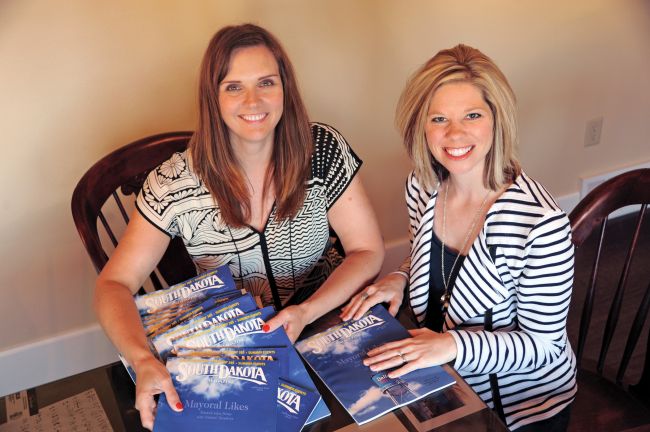
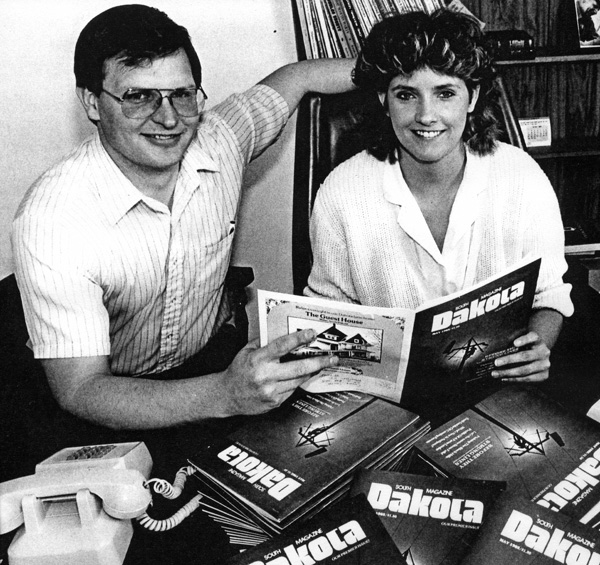
Katie Hunhoff (top left) and Heidi Marsh are the new publishers of South Dakota Magazine in Yankton. Bernie and Myrna Hunhoff (above) started the magazine nearly 30 years ago.
Forty years ago, I landed a writing job with the Watertown Public Opinion. Just in time, as it turned out, because our son Chris was born a few months later.
Well, I’ve been writing and poking about in South Dakota ever since — along with raising Chris and his sister Katie, some political tomfoolery and so on. Myrna has been a pretty and nice partner every step of the way.
After a few years of writing for the Watertown and Madison newspapers, we started a weekly newspaper. And then, 30 years ago, we started this magazine with the simple idea that South Dakota’s stories deserved telling.
I’m at that awkward time where I’m old enough to know that I probably can’t do this forever, and yet I’m good for a few more years.
I do believe that South Dakota Magazine needs a new generation of leadership and we have it in Katie Hunhoff and Heidi Marsh. Those young ladies became friends 25 years ago as horse-crazy kids in Yankton County’s 4-H program. They’ve been working together here at the magazine for several years (Katie for 12 and Heidi for 6). Now they’re creating a partnership to be your new publishers.
They’re smart and enthusiastic, and they understand something important that I learned through the years: South Dakota Magazine really belongs to you and the other 180,000 readers. Still, somebody needs to see that the postage is paid and the stories have good pictures, and Heidi and Katie are taking on that responsibility. I’m sure their family style of leadership will better serve our readers than the corporate alternatives that are swallowing up most of today’s media.
They are also blessed with a wonderful and talented staff of 10 here at the magazine that cares deeply about South Dakota. We’ve all come to learn that the magazine helps readers establish a sense of place, and to more greatly appreciate and enjoy life in South Dakota. That makes our hard work feel very worthwhile.
Katie and Heidi assure me that they’ll let me do some writing, which is all I wanted to do when I started working for the Watertown paper in 1974. So I’ll see you along a South Dakota road.
Meanwhile, if you have a complaint about a story or photo, call Katie or Heidi. Unless it’s something I wrote. Then please don’t tell the bosses. They seem nice enough, but at my age I don’t want to give them any reason to take away my keys.
— Bernie Hunhoff
Rolling Onward
August 29, 2014
Travelers were arriving in Yankton by train, horse and steamboat 125 years ago when South Dakota gained statehood.
Steamboats and passenger trains are long gone, but visitors will be coming with horses next week in the old Missouri River city, where a quasquicentennial wagon train will begin on Thursday (Sept. 4). The public is welcome to join the wagoneers for a celebration of statehood on Wednesday afternoon and evening (Sept. 3). Headquarters for the festivities is the rodeo grounds, a half-mile west of the intersection of Highways 50 and 81 on the far northside of Yankton.
From noon to 5 p.m., tours will be offered of a museum-in-progress — the restoration of the historic Mead Building as a new home for Yankton’s old Territorial Museum. Wagon rides will be provided from the rodeo grounds to the nearby museum (pulled by an old tractor, not a horse.) A chicken dinner will be served from 5-7 p.m., with proceeds going to the museum project. Tickets may be obtained in advance at the Territorial Museum. Tickets may also be purchased at the event on a first-come, first-serve basis.
A program of music and history also begins at 5 p.m., hosted by Terry Crandall. The agenda includes singer Mike McDonald, a re-enactment of the first governor by actor John Timm, songs by the Beadle School first-graders, more music by country singers Rachel Wood and Ashley Schweitzer, a speech by wagonmaster Gerald Kessler and remarks by Governor Dennis Daugaard.
A concert and dance will ensue from 7 to 10 p.m., featuring the country/folk songs of Poker Alice. All the activities except the meal are free. No beer or alcohol will be served at the program or dance, so bring the kids and grandkids. This is an opportunity for them to get a sense of the spirit of challenge and adventure that has marked the history of their home state.
Everyone is encouraged to dress in western wear, contemporary or historic. Commemorative t-shirts are available at the Chamber of Commerce for $12. They will also be sold at the event on Wednesday. The t-shirt slogan reads, “Happy Trails to You, Until We Meet Again in Yankton.”
Who Owns Them?
August 22, 2014
The border between the two Dakotas is unique in the nation because it is divided by hundreds of granite markers, erected shortly after the two states were welcomed into the Union.
Charles Bates headed a hard-working crew that installed the markers in 1891. They were erected every half-mile along the 360-mile border. Many have stood the test of time, but a number have been lost to vandals, thieves and the Dust Bowl. Those still visible have sunk to about half of their original height.
A smalltown museum curator in northern South Dakota contacted us today, wondering how they might obtain one of the markers for exhibit. But there's the question of who to contact. Who owns them? Who can give permission for such a task? We're going to try to get them an answer, and we'll keep you posted.
We know there are other museums with the stones on display, and in fact the Cultural Heritage Center in Pierre has one by its flagpole outdoors. Someone apparently dropped it off.

